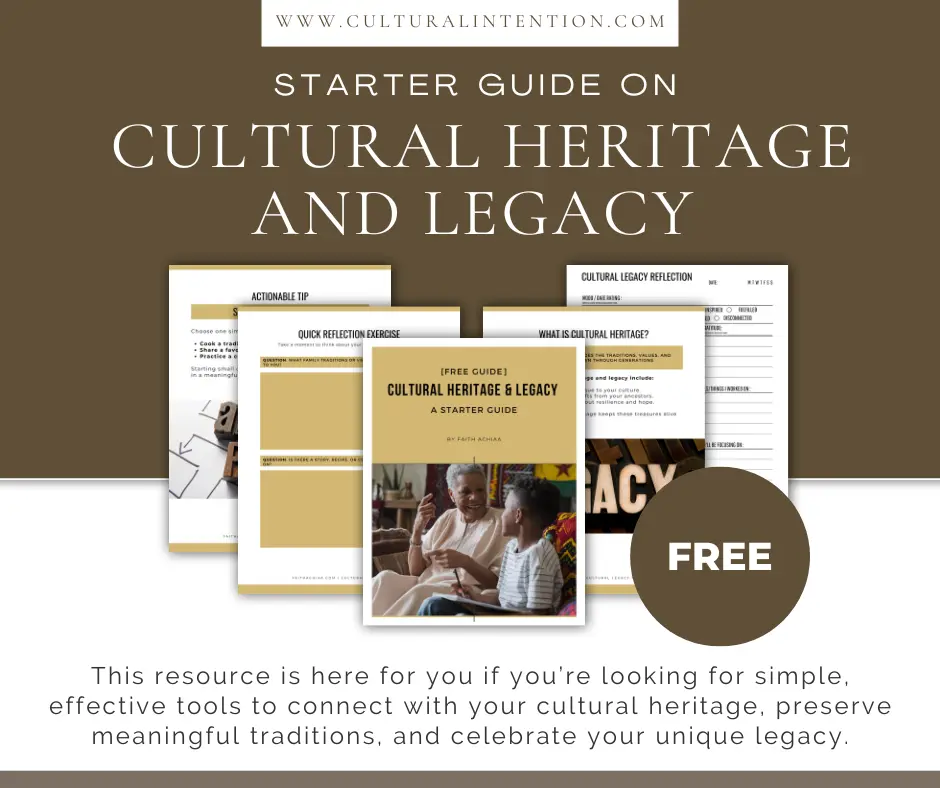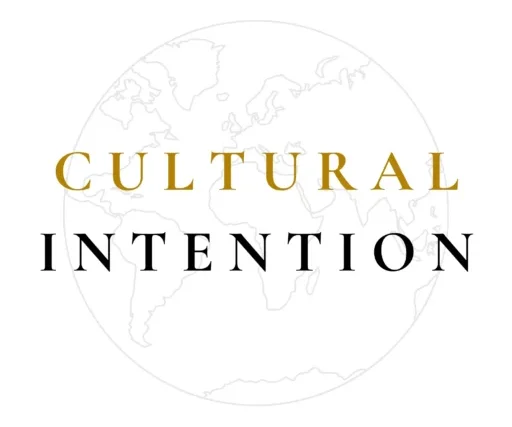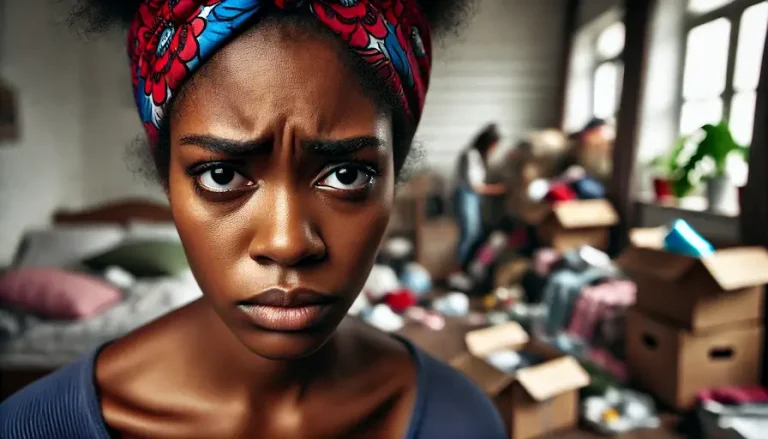Cultural Appropriation vs. Appreciation: How to Show Respect Across Cultures

Is adopting elements from other cultures harmless, or does it cross a line?
I’ve always loved seeing different cultures come together through food, music, language, or clothing.
But sometimes it’s hard to tell if something is being appreciated or used for status, profit, or to follow a trend.
I’ve seen people get praised for things others were once punished or mocked for. That shift can feel confusing and unfair.
So, how do we explore other cultures in a thoughtful and respectful way?

Honor Your Past.
Shape Your Legacy.
Download your FREE starter guide on Cultural Heritage & Legacy—created to help you preserve what matters, honor your traditions, and pass your story on with pride.
What Culture Means and Why It Matters
Many of us think of culture as holidays or clothing styles, but it's more present in our everyday lives than we realize.
From the meals we cook to how we greet one another, culture influences us daily.
Culture is what makes communities unique. It includes traditions, values, languages, and ways of living. It shapes how people interact, pass down history, and find meaning.
Culture goes beyond customs. It affects how we live, connect, and understand the world. It’s in how we celebrate, mourn, and how we remember.
It helps us feel grounded, even when far from home or how we were raised.

Cultural Appropriation vs. Cultural Appreciation
Cultural appropriation occurs when someone takes parts of another culture without understanding or respect, especially from groups that have been pushed aside or disrespected. It often flattens rich traditions for entertainment or style, stripping away meaning.
Cultural appreciation is about learning from and respecting a culture. It means honoring where practices come from and why they matter.
Intent matters. Are you learning, connecting, and showing respect or copying without care, even if it feels harmless?
“I didn’t mean harm” doesn’t undo the harm. If it benefits one group while another continues to be left out or judged, it’s worth thinking about.
Understanding Culture and Its Role in Identity
Identity has layers for many of us in multicultural families or who’ve crossed borders.
Culture helps us hold onto the parts of ourselves that remind us of who we are and where we come from.
Storytelling in African communities, tea ceremonies in Japan, and respectful greetings and titles used for elders in many Asian and African cultures are daily practices that show us how people live their values.
Language and food shape my identity. A dish like jollof rice reminds me of home, but so do greetings and small customs that carry meaning across generations.
Globalization has blurred lines. I’ve seen kente prints and ‘Ghana Must Go' bags on runways.
That can be exciting, but it also raises the question: Are people truly celebrating the culture or simply using it without understanding?
Sharing can be beautiful, but we lose something important if the meaning gets lost or stripped away.

Why Cultural Appropriation Is Harmful
I didn’t always understand cultural appropriation. I first heard the term when Bo Derek wore cornrows in a movie.
At the time, I didn’t get the issue. Later, I noticed how braids and locs were labeled “too ethnic” on Black women but praised on white celebrities.
That opened my eyes to how power shows up in perception.
That’s when I heard “culture vulture”, someone who takes from culture to seem interesting, without real respect for the people it comes from.
It stuck with me because it felt like watching someone treat your reality like a costume.
Many of us are now reclaiming what was once mocked or erased. Hairstyles, clothing, language, these are part of who we are. Taking them back is personal.
But when others use those same things to profit or stand out, it hits differently. That’s where the harm starts.
Appropriation turns culture into a product, something to buy, copy, and resell—often without credit or benefit to the originators.
- Fashion: Headdresses and African prints on runways without mentioning their origins.
- Music: Black genres are copied without acknowledgment, while the originators stay overlooked.
- Spirituality: Practices like smudging become trendy kits, ignoring their sacred origins.
These actions flatten culture into something disposable instead of something lived.

Appropriation Is About Power, Not Just Style
This isn’t just about copying a style or following a trend. It’s about power, who gets seen, heard, and benefits.
People are celebrated for what others were punished or shamed for.
Think of how slang, fashion, or even ways of dancing are received differently depending on who’s doing it.
When Black people wear locs or speak AAVE (African American Vernacular English), it’s judged.
When non-Black influencers do the same, it’s praised as creative. That double standard isn’t just frustrating. It’s harmful.
When people speak up about unfair double standards of conversations about hair, they’re often told they’re overreacting or reminded that some Black women wear blond wigs and straight hair.
But here’s the difference: Wearing wigs or straight styles is often about adapting to beauty norms shaped by colonial history, media bias, and professional pressure, not copying or profiting from someone else’s culture.
That’s not the same as adopting cultural elements without understanding.
One comes from navigating bias, and the other comes from convenience, without facing the same consequences.
That’s why cultural appropriation isn’t harmless. It minimizes identity and turns lived experience into something others can put on and take off at will.
Across the world, communities are pushing back. In the U.S., the CROWN Act tackles hair discrimination, ensuring people can wear their natural hair in schools and workplaces without punishment.
Similar efforts are happening globally, from language preservation programs to cultural protection laws.
These aren’t just political changes. They’re reminders that honoring culture is about more than pride; it’s about rights, representation, and respect.

How to Prevent Cultural Appropriation
It starts with being thoughtful:
- Educate Yourself: Learn the origins and meanings behind the cultural items you admire.
- Engage Respectfully: Attend events or learn directly from those within the culture.
- Support Authentic Sources: Buy from creators or small businesses rooted in the culture.
- Reflect Often: Ask yourself, “Would I feel okay if someone used my culture this way?”
Real-Life Ways to Appreciate Culture
Appreciation means taking time to understand and build a connection:
- Language Learning: I remember trying out a few Turkish phrases at a Turkish restaurant and seeing the surprise turn into a smile. Even small efforts in someone else’s language can build trust and show that you see them as more than a backdrop to your curiosity.
- Food and Cooking: Learn the story behind a dish and give credit where it’s due.
- Fashion and Symbols: Compliment respectfully. Ask questions. Support designers or artists from that culture.
Not long ago, someone complimented my Ankara headwrap. I don’t wear it for religious reasons.
I wear it because I love how it connects me to Ghana and lets me express pride in my roots.
When people ask, I enjoy sharing more about the fabric and the meaning it carries.
The same goes for belly beads worn in many West African cultures.
Some people see them as decorative or trendy, but they often represent womanhood, stages of life, or beauty. Sharing those meanings helps shift how people see them.
Once, I nearly bought a pair of earrings with Adinkra symbols for $2 on Shein because they looked nice.
But something didn’t sit right. I realized I was about to buy a cheap, mass-produced version of something deeply cultural.
I ended up spending more to support a small business owned by someone who understood the significance behind the design.
That felt better, not just because it was ethical, but because it was meaningful. But how many of us can honestly say that we do this?
I love seeing Adinkra earrings for fifty cents, but who am I really supporting—and what am I preserving?

Mutual Cultural Exchange Matters
Sharing culture isn’t one-sided. Appreciation should go both ways.
Openly offer your traditions, languages, and values. That’s where real exchange happens—not just learning but connecting.
What About Blending?
Cultures mix and influence each other all the time. That’s not new. But there’s a difference between blending with respect and borrowing with disregard.
Blending comes with understanding, consent, and shared benefit. Appropriation happens when one group takes without acknowledgment and profits while the original culture is ignored.
It’s okay to ask where the line is. If someone gains visibility using a cultural element, while people from that culture still struggle for recognition, that’s not blending. That’s an imbalance.
Questions to Check Yourself
- Have I learned the background of what I’m using or wearing?
- Did I hear it from someone in that culture, or copy it from Pinterest or social media?
- Would I be okay if someone used my own culture this way?
- Am I benefiting, or is the community also gaining something?

Listen Before Acting
Appreciation starts with listening. What stories are people from that culture telling? What are they asking others to understand?
This is especially important if you’re raising multicultural kids. Don’t just celebrate culture during a holiday; connect it to everyday life.
Share the reasons behind your food, language, and ways of showing respect.
Quick Respect Checklist
If you’re unsure:
- Is this item tied to a specific cultural or spiritual meaning?
- Did I learn about it from someone within the culture?
- Is credit given, and does the benefit go back to that community?

Cultural Appreciation Is Ongoing Work
Cultural exchange should feel like a conversation, not a costume party. Ask questions, build relationships, and reflect often.
Whether you’re learning a dance, sharing a dish, or using a phrase in another language, think about how it’s received, what it means, and how you can show respect.
Genuine appreciation means paying attention, being honest about your intent, and listening before acting. Respect isn’t a trend. It’s a practice.
“Cultural appropriation is about the power to take. Cultural appreciation is about the power to engage.” – Dr. George Lipsitz
If this post made you pause or reflect, share it. Start a conversation with your kids, friends, or group chat.
You don’t need all the answers to get started. Just a willingness to listen, reflect, and grow.
If you’ve ever wondered whether you’re honoring a culture or just enjoying what’s on the surface, ask yourself: Who taught me this? Who benefits from this? What story am I continuing?
Appreciating a culture isn’t just about liking what you see. It’s about understanding what it means, how it’s used, and why it matters.

If you’re raising multicultural kids, reconnecting with your roots, or figuring out what respectful curiosity looks like in real life, keep talking about it.
And if you’ve had a moment where this came up in your own world, I’d love to hear how you handled it. Your story matters too.
IF THIS POST SPOKE TO YOU, EXPLORE MORE OF THE JOURNEY ON OUR SITE.
You'll find free guides, intentional tools, and reflections to support cultural growth and legacy-building.
💬 Looking for connection? Join our Facebook community to continue the conversation.
📌 Pin an image to revisit or share with someone walking a similar path.
Thank you for being here.









